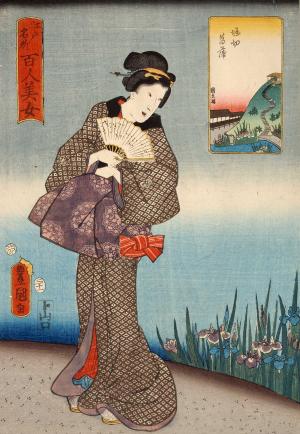Famous Places in Edo, Hundred Beautiful Women, Horikiri Shōbu (Edo Meisho Hyaku-nin Bijo Horikiri Shōbu)
by Utagawa Toyokuni III and Utagawa Kunihisa II 1857 (Ansei 4) Tokyo Shiryō Collection 025-C1-87
This picture depicts a lady coming to see Horikiri, a place famous for its irises. From early times, many sightseers came during the flowering season to the iris garden of Horikiri in the Katsushika Ward, which remains to this day.
The iris is an essential flower for the Tango Festival. Irises were like a protective amulet to the people of Edo who feared epidemics and diseases in the run up to summer and the practices of drinking iris sake as well as submerging oneself in iris bath were carried out in the belief that it would also dispel evil and have an effect against poisoning from snakes and insects.
It is not known when irises were brought to Horikiri. It is said by some that Shogen Miyata, the retainer of an estate steward of the area, Taneo Kubodera in the Muromachi period, had irises brought from the Asaka marsh (present day Koriyama City, Fukushima Prefecture) and started cultivating them and it is also said by some that during the Bunka period (1804-1818), a local farmer called Izaemon was interested in irises and received varieties including 'juni-hitoe' from Rokusaburo Mannen, the local hatamoto, 'hagoromo' and 'tatsutagawa' from the iris lover Sakingo Matsudaira, and began cultivating the irises.


